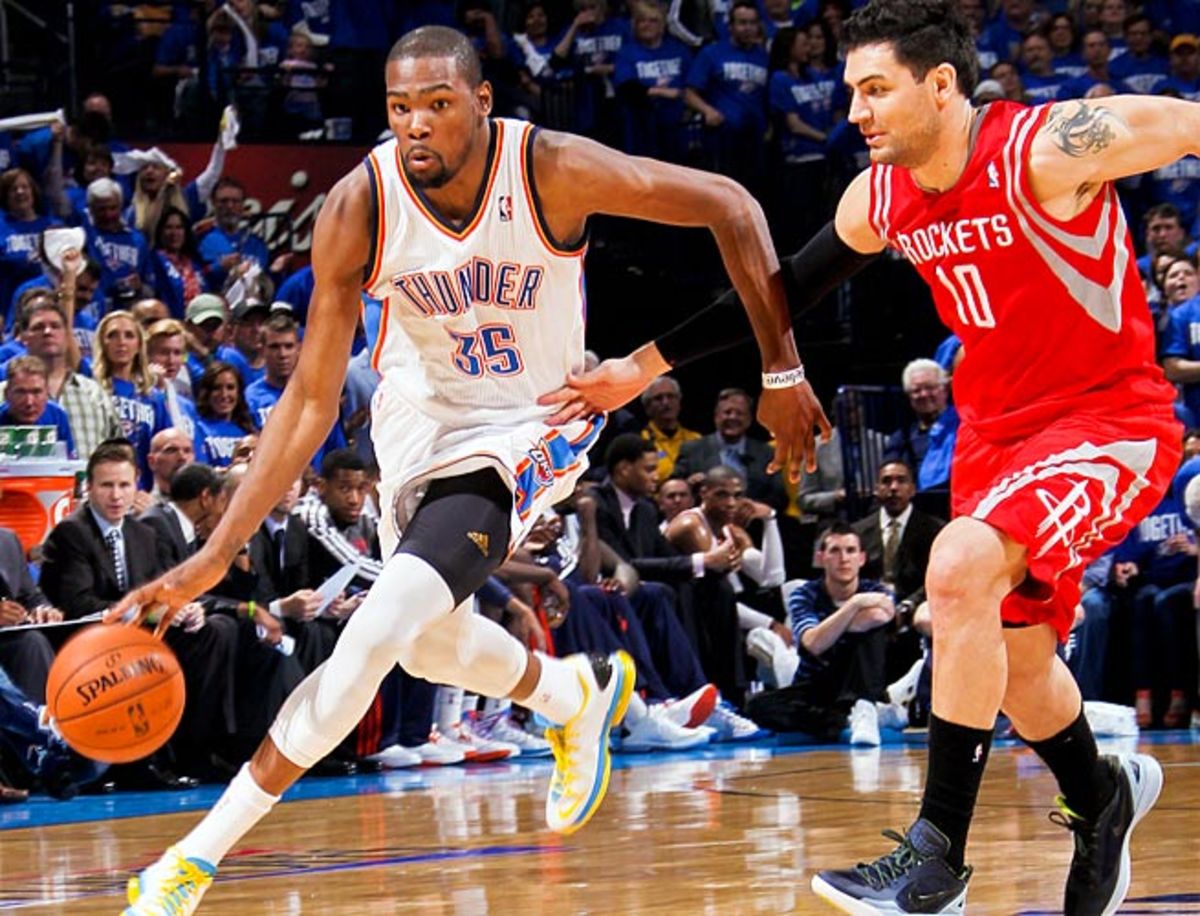With Westbrook out, the ball is in Durant's hands


Kevin Durant would dribble up and down the street outside his grandmother's house in Capitol Heights, Md., so bound was he to be a point guard. He played the point as a freshman at National Christian Academy in Fort Washington. He ran it during pickup games. He watched And1 DVDs to study crossovers.
"Where I'm from, you got to have the ball," Durant said. "That's how we do it. We streetball."
Between Durant's freshman and sophomore seasons in high school, he sprouted five inches, from 6-3 to 6-8. His jumper didn't suffer, but his handle did. "I still had the moves," Durant said. "But I dribbled way too high." I wrote a feature about Durant for this week's Sports Illustrated, and while the quote on the cover received most of the attention ("I'm tired of being second. I'm done with it"), the story is mostly about how Durant became a creator again.
Oklahoma City announced Friday that starting point guard Russell Westbrook, who had played all 439 games since entering the NBA five years ago, is out indefinitely after tearing the meniscus in his right knee in Wednesday's 105-102 victory against the Rockets in Game 2 of a first-round series. At a moment like this, the Thunder could use James Harden, who was shipped to Houston in October, or Eric Maynor, who was sent to Portland in February. But one reason they withstood those losses, besides the consistency of Westbrook and the emergence of second-year guard Reggie Jackson, is the improved playmaking of Durant. Like LeBron James in Miami, Durant could now become the equivalent of an oversized second point guard.
THOMSEN: Westbrook's injury will test Durant's leadership
During the summer of 2011, when NBA players were locked out, Durant sparked a hundred highlights with all of his scoring binges at pickup games. What the cameras didn't show were his 6 a.m. workouts at Bryant Alternative High School in Alexandria, Va., where trainer Justin Zormelo pushed down on his shoulders to physically lower his dribble. Durant would occasionally grow frustrated, especially when trying to rebuild his crossover. "I'm never really going to use this!" he shouted. But at all those pickup games, he asked to play point guard, and in free time he watched tape of Magic Johnson and Larry Bird.
Durant was motivated in part by all the double and triple teams coming his way. He could shoot over anyone, but to consistently burn those lopsided defenses, he had drive and find open teammates. When Harden left, Durant was able to take over his role as the ball-handler in the pick-and-roll, and the Thunder actually scored more points per game this season than last. Durant dished out a career-high 4.6 assists, and though he also averaged 3.5 turnovers, he has lowered that crossover to a level no big man can reach.
"Remember when tall guys would come into the league and people would say, 'They handle like a guard!' but they never actually did handle like a guard?" Thunder forward Nick Collison said in the magazine story. "Kevin really does handle like a guard."
For a dynamic star, anything is possible in today's NBA. At 6-8, James brings the ball up the court for the Heat in the fourth quarter, posts up and initiates offense from inside or out. At 6-9 -- and he is really more like 6-11 -- Durant continues to stretch the limits of what we believe a human being of his size can do. He is not as developed a playmaker as James, but he is starting down the same course. The Thunder estimate that he brought the ball up the court 20 percent of the time this season, a number that will surely spike in Westbrook's absence.
Without his prolific sidekick, it looks like Durant can do no better than second again. Of course, it also looked that way when Harden left, and coach Scott Brooks told the team: "We're not taking a step back." Instead of firing more shots, the predictable response, Durant took fewer. He became consumed with hot zones and efficiency figures. He consulted with Zormelo, who doubles as an analytics expert, and identified the best spots on the floor to let fly. Durant's judiciousness was rewarded -- he became only the sixth player to shoot higher than 50 percent from the field, 40 percent from three-point range and 90 percent from the free-throw line -- but he may need to become more liberal about his shot selection moving forward.
The Thunder have always been Durant's team, but he shared the burden with Westbrook. Sometimes, he needed the extra hand, and sometimes it seemed to get in his way. When Durant struggled, he could feed Westbrook, but when he surged, Westbrook wouldn't necessarily feed him. For now, there won't be anybody to help Durant, and there won't be anybody to hinder him. The ball is in his hands.
